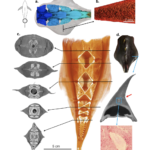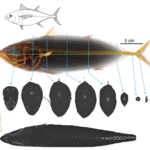Paper, Tunas as a high-performance fish platform for inspiring the next generation of autonomous underwater vehicles
Abstract: Tunas of the genus Thunnus are a group of high-performance pelagic fishes with many locomotor traits that are convergently shared with other high-performance fish groups. Because of their swimming abilities, tunas continue to be an inspiration for both comparative biomechanics and the design of biomimetic autonomous underwater vehicles (AUVs). Despite the strong history of studies in tuna physiology and current interest in tuna biomechanics and bio-inspired design, we lack quantitative data on the function of many features of tunas. Here we present data on the morphology, behavior, and function of tunas, focusing especially on experimentally examining the function of tuna lateral keels, finlets, and pectoral fins by using simple physical models. We find that both triangular lateral keels and flexible finlets decrease power requirements during swimming, likely by reducing lateral forces and yaw torques (compared to models either without keels or with rectangular keels, and models with stiff finlets or strip fins of equal area, respectively). However, both triangular keels and flexible finlets generate less thrust than other models either without these features or with modified keels or finlets, leading to a tradeoff between power consumption and thrust. In addition, we use micro computed tomography (µCT) to show that the flexible lateral keels possess a lateral line canal, suggesting these keels have a sensory function. The curved and fully-attached base of tuna pectoral fins provides high lift-to-drag ratio at low angles of attack, and generates the highest torques across speeds and angles of attack. Therefore, curved, fully-attached pectoral fins grant both better gliding and maneuvering performance compared to flat or curved, partially-attached designs. We provide both 3D models of tuna morphology derived from µCT scans and conclusions about the performance effects of tuna-like features as a resource for future biological and engineering work for next-generation tuna-inspired AUV designs.
Learn about our two Decals!
 Click here to find out more about our Fall Bioinspired Design Decal and our Spring Bioinspired Design in Action Decal – ALL MAJORS are welcome.
Click here to find out more about our Fall Bioinspired Design Decal and our Spring Bioinspired Design in Action Decal – ALL MAJORS are welcome.Berkeley BioDesign Community
 Click here to learn about the BioD: Bio-Inspired Design @ Berkeley student organization or here to signup for more info.
Click here to learn about the BioD: Bio-Inspired Design @ Berkeley student organization or here to signup for more info.Search
Student Login






I imagine that the neurological circuits underlying these processes are governed by both 2d spacing maps with their brains as…
to reduce the impact of car accidents, it may be possible to study the force diverting physics of cockroaches to…
you see this type of head-bobbing stability in many avian creatures related to pigeons like chickens. the head ability to…
not like they taught horses how to run! this is an example of convergent evolution where both sea creatures and…
The brain functions in a similar way with neuronal connections. our brains are able to utilize the multiplicity of connections…